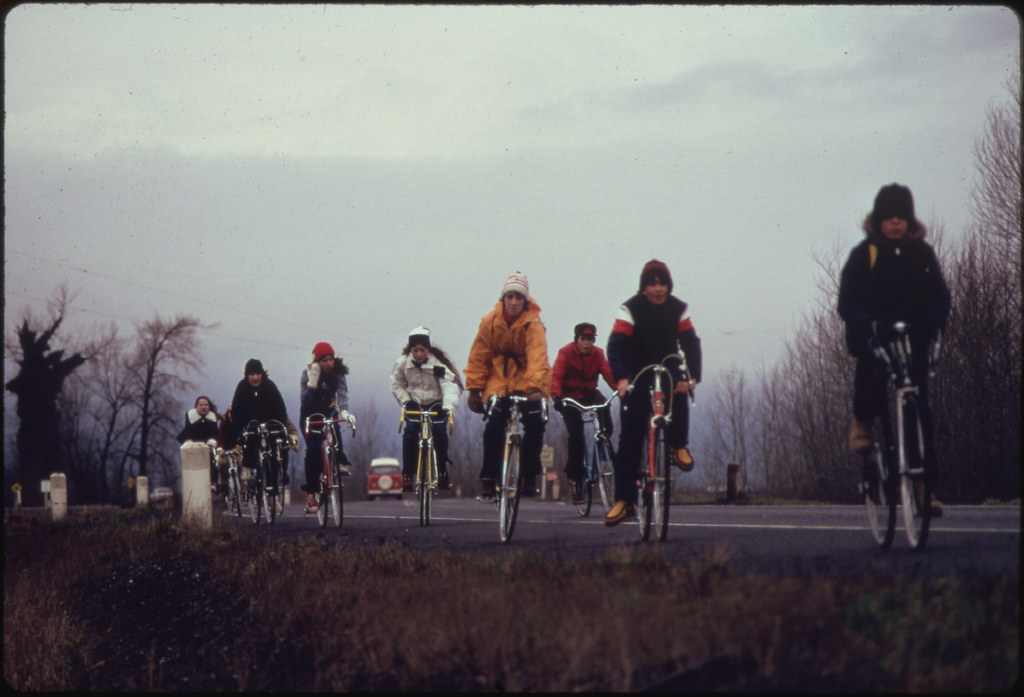Summary: Cycling is the most sustainable transport method because its fuel supply cannot run out, it is accessible by almost everyone in any location, it doesn't require mass participation, it isn't dependent on massive public funding for viability, it is efficiently scalable, and the infrastructure and laws in any city can be readily modified to support it. Hence, choosing to cycle for transport is a smart, long-term choice.
Magnificent Octopus
Details:
1. Cycling's fuel supply won't run out or be affordable only by the wealthy
- Just like the cartoon shows, cars are especially dependent on an energy source that is costly, inefficient (moving 2000kg when a person weighs 70kg), finite and subject to supply fluctuations. This is why there is permanent concern about fuel prices and long-term supply; it really does affect the mobility of those who've made themselves dependent on cars.
- While public transport can be more readily converted to renewable or electric sources, the fuel cost isn't ever going to be cheap and building broad, affordable, regular access for all citizens is a constant challenge.
U.S. National Archives: School Children, Were Forced to Use Their Bicycles on Field Trips During the Fuel Crisis in the Winter of 1974
2. Cycling is potentially accessible by almost everyone in all locations
- Cars are not genuinely affordable (to own or run) by much of the population and so access to them is always going to be constrained. Public transport can be made accessible from a cost perspective but expanding and maintaining access to every part of a city is not feasible - there will always be poorly-serviced or unserviced citizens.
- Investing in safe cycling infrastructure, including routes that link with public transport, is a far more sustainable option. So when deciding where to live, consider how cycling-friendly the area is and the cycling links with public transport. See: > Choose where to live with cycling and your commute in mind
3. Cycling's utility is determined by each individual not mass participation
- It is desirable that safe, convenient cycling be available to all urban residents but its utility to each individual is mostly dependent on their individual choices and circumstances (which they have significant control over). In most cities, you can make wiser choices to get many immediate benefits out of cycling for transport - regardless of what everyone else chooses, supports or votes for.
- Conversely, public transport routes, times and expansion are always subject to mass participation. And cars require constant, car-specific investment (maintenance, tunnels, toll roads, ring roads, etc.) that is also dependent on mass participation and support.
4. Cycling isn't dependent on massive public funding
- Networks of safe, direct cycling routes can be built with much less money than is required for cars or public transport. Councils in local areas can quickly improve cycling transport routes with limited investment. You can choose to reside in local areas that have safe, efficient cycling routes or are building them, irrespective of whether the entire state is massively investing.
5. Cycling is efficiently scalable in large cities
- Private cars have proven not to be efficiently scalable in large cities; building more roads and tunnels ultimately can't resolve congestion, especially during peak hours. Public transport is also ultimately limited in peak hours when it is really needed. When the rich start using helicopters to get around cities (e.g. Brazil, India) you know the future of the car for intra-city transport is bleak.
- Conversely, cycling is readily scalable as bikes take up so little space, can run anywhere and congestion is never intractable - more space can be readily allocated to bicycles as usage increases. Routes can also be more flexible and distributed.
6. Cycling takes up much less space (travel and parking) in cities
- A sheer lack of space is a major sustainability and scalability issue for cities. The transport modes used by citizens is a major contributor not just to congestion but also to the amenity of cities and streets. This has been illustrated best using photos such as the one below. See: Planetizen: Mobility in Cities is About Space - Proven Powerfully in Pictures!
Mobility in Cities is About Space - Iowa street space comparison
- It's not just the vehicle size per person that matters but the overall space occupied in cities by infrastructure for that mode (e.g. roads), travel spacing (e.g. between cars on highways) and parking (a massive factor). As you can see in the chart below, walking, cycling and public transport are far more space efficient than cars. Solo driving on highways is so space inefficient that it can't be provided sustainably and affordably to all city residents.
Mobility in Cities is About Space - Iowa street space comparison
7. City infrastructure and laws can readily be modified to facilitate cycling
- At whatever level/area the political will and planning wisdom exists, infrastructure and laws/rules can readily be modified to facilitate cycling as a safe, convenient and efficient mode of transport.
- Hence, you can make choices about where to live and work/study that take advantage of the places where cycling is easiest and most beneficial.
8. Cycling is a key element of holistic sustainable transport improvements
- Regardless of whether cycling is superior to other modes, all sustainable transport models include facilitation of cycling as an essential element. This is because cycling is a natural fit with the overarching drivers of efficient use of space and resources, cost, access, flexibility and liveability.
- An excellent illustration of these integrated, sustainable transport principles is here: > 10 principles of sustainable urban transport
10 principles of sustainable transport
Further Info:
Cycling as the catalyst for more human and sustainable transport
City of Yarra - Bikes and sustainable transport
Sustainable Cities Collective - Biking
Planetizen: Mobility in Cities is About Space - Proven Powerfully in Pictures!
Wired: What’s Up With That: Building Bigger Roads Actually Makes Traffic Worse










